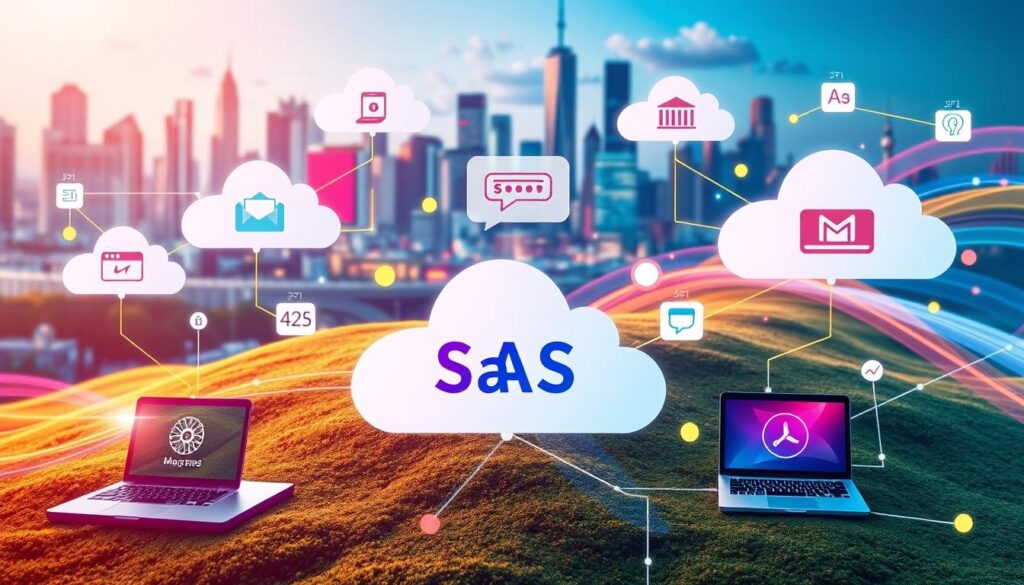Table of Contents
SaaS vs PaaS, In the world of cloud computing, two main models stand out: Software as a Service (SaaS) and Platform as a Service (PaaS). As businesses grow, knowing the differences between SaaS and PaaS is key. This article will help you understand these differences, so you can choose the best cloud solution for your company.

Key Takeaways
- SaaS and PaaS are two distinct cloud computing models with unique characteristics and benefits.
- SaaS provides end-users with access to software applications hosted on the cloud, while PaaS offers a platform for developers to build, test, and deploy applications.
- SaaS solutions are typically more user-friendly and require less technical expertise, while PaaS provides more control and customization options for developers.
- Pricing models for SaaS and PaaS can vary, with SaaS often following a subscription-based approach and PaaS offering more flexible, usage-based pricing.
- Choosing between SaaS and PaaS depends on factors such as business requirements, technical expertise, and the desired level of control over the underlying infrastructure.
What is Software as a Service (SaaS)?
Software as a Service (SaaS) is a cloud-based way to deliver software. It has changed how businesses use applications. In this model, a provider hosts and manages the software, making it available over the internet. SaaS offers many benefits, making it popular among businesses.
Definition and Key Characteristics
SaaS, or software as a service, is a way to license and deliver software. It’s hosted centrally and accessed through a web browser or mobile app. The main features of SaaS include:
- Cloud-based deployment: SaaS applications are hosted on the provider’s servers, eliminating the need for on-premises infrastructure.
- Subscription-based pricing: Users typically pay a monthly or annual subscription fee to access the software, rather than a one-time license fee.
- Automatic updates: The provider is responsible for maintaining, updating, and securing the software, ensuring users always have access to the latest features and functionality.
- Scalability: SaaS solutions can easily scale up or down to accommodate changes in user demand or business needs.
Benefits of SaaS Solutions
The benefits of SaaS for businesses are many, including:
- Reduced IT infrastructure costs: With SaaS, companies can avoid the upfront expenses of hardware, software, and IT maintenance.
- Improved accessibility: SaaS applications can be accessed from any device with an internet connection, enabling remote and mobile access.
- Automatic updates: SaaS providers handle software updates and patches, ensuring users always have access to the latest features and security improvements.
- Increased scalability: SaaS solutions can easily scale up or down to meet changing business needs, without the need for additional hardware or IT resources.
In summary, SaaS has become a top choice for businesses. It offers a flexible, cost-effective, and scalable way to access software and tools needed to succeed in the digital age.

What is Platform as a Service (PaaS)?
Platform as a Service (PaaS) is a cloud computing model. It gives developers a complete platform for building, testing, and deploying apps. This includes operating systems, programming languages, databases, and web servers. Developers can focus on their app’s logic without worrying about the infrastructure.
Understanding PaaS Offerings
PaaS offers a wide range of services for developers and businesses. Key PaaS offerings include:
- Application Development and Deployment: PaaS platforms have tools and frameworks for building and deploying apps. This streamlines the development process.
- Database Management: PaaS solutions include database management services. Developers can easily manage and scale databases without needing to know a lot about database administration.
- Middleware and Integration: PaaS offerings include middleware services. These services help different parts of an app communicate and integrate smoothly.
- Scalability and Elasticity: PaaS platforms allow for dynamic scaling. Developers can scale their apps up or down as needed, ensuring performance and cost-efficiency.
- Monitoring and Analytics: Many PaaS providers offer monitoring and analytics tools. These tools provide insights into app performance and resource usage, helping with decision-making and optimization.
By using PaaS, developers can speed up app development and deployment. They can focus on innovation and business logic, not infrastructure management.

| PaaS Offering | Description |
|---|---|
| Application Development and Deployment | Provides tools and frameworks for building, testing, and deploying applications. |
| Database Management | Includes integrated database management services for easy creation, management, and scaling of databases. |
| Middleware and Integration | Offers middleware services like message queues, API management, and integration tools for seamless communication. |
| Scalability and Elasticity | Enables dynamic scaling of applications based on changing demands for optimal performance and cost-efficiency. |
| Monitoring and Analytics | Provides built-in monitoring and analytics tools for insights into application performance, usage, and resource utilization. |
SaaS vs PaaS
As cloud computing grows, companies face a choice between SaaS and PaaS. Both have their benefits, but knowing the differences is key. This helps pick the best cloud option for your business.
SaaS and PaaS are cloud services that don’t need on-premises setup. But, they differ in control, customization, and who they’re for.
Comparing SaaS and PaaS
| Characteristic | SaaS | PaaS |
|---|---|---|
| Deployment and Management | SaaS is fully managed by the provider. They handle updates and infrastructure. This eases the IT load for users. | PaaS gives more control and customization. Users manage the platform and deploy apps. The provider handles infrastructure and basic updates. |
| Target Audience | SaaS is for many users, from individuals to small businesses. It offers easy-to-use apps that don’t need much tech know-how. | PaaS is for developers and IT teams. They use it to build and deploy custom apps without managing infrastructure. |
| Use Cases | SaaS is great for common business software like CRM and web email. | PaaS is best for developers who need a flexible platform to create and deploy apps. |
Understanding the differences between SaaS vs PaaS helps companies choose the right cloud model. This choice should match their business needs and tech skills.
Key Differences Between SaaS and PaaS
Software as a Service (SaaS) and Platform as a Service (PaaS) are cloud-based models. They differ in deployment, management, and pricing. Knowing these differences helps businesses choose the right option for their needs and resources.
Deployment and Management
In SaaS, the provider manages everything, from hardware to software. Users just access the app through a browser or mobile app. The provider takes care of updates and security.
PaaS, however, gives users more control. They manage their apps, while the provider handles the platform and infrastructure.
Pricing Models
- SaaS uses a subscription model. Users pay a recurring fee, monthly or yearly, to use the app.
- PaaS charges based on usage. Users pay for the resources they use, like computing instances or storage.
Choosing between SaaS and PaaS depends on your organization’s needs. SaaS is good for those wanting a simple solution with little IT work. PaaS is better for those with technical skills wanting more control over their apps.
“The choice between SaaS and PaaS is not about one being inherently ‘better’ than the other, but rather about finding the solution that best fits your organization’s unique needs and resources.”
When to Choose SaaS or PaaS
Choosing between SaaS and PaaS depends on several key factors. You need to think about how much control you want, if you need to customize, and how complex your application is. These elements help decide which option is best for you.
Factors to Consider
If you want something easy to use and quick to set up, SaaS might be right for you. It’s great for businesses with limited IT skills. On the other hand, if you need to customize a lot or integrate with other systems, PaaS could be better. It gives you more control over your environment and infrastructure.
PaaS is good for companies with complex needs. It lets you build custom apps that fit your business perfectly. But, it requires more effort and IT management. You should also think about scalability, security, and cost when making your choice.
FAQ
What is Software as a Service (SaaS)?
SaaS, or Software as a Service, is a cloud-based way to deliver software. It’s hosted by a provider and accessed over the internet. Users can get to it through a web browser or special software.
What are the key benefits of SaaS solutions?
SaaS solutions offer many advantages. They cut down on IT costs and make updates automatic. You can also scale them easily and access them from anywhere with internet.
With SaaS, you don’t have to buy, install, or maintain software yourself. It’s all handled by the provider.
What is Platform as a Service (PaaS)?
PaaS, or Platform as a Service, is a cloud model. It gives you a platform to build, test, and deploy apps. This includes operating systems, programming languages, databases, and web servers.
How does PaaS differ from SaaS in terms of deployment and management?
SaaS and PaaS differ in who manages the infrastructure. In SaaS, the provider handles everything. In PaaS, the provider manages the platform, but you manage your apps.
What factors should I consider when choosing between SaaS and PaaS?
Choosing between SaaS and PaaS depends on several factors. Consider how much control and customization you need. Think about the complexity of your app and your scalability needs.
Also, look at your IT resources. SaaS is good for smaller businesses or those with limited IT. PaaS is better for larger organizations that need more control and customization.

